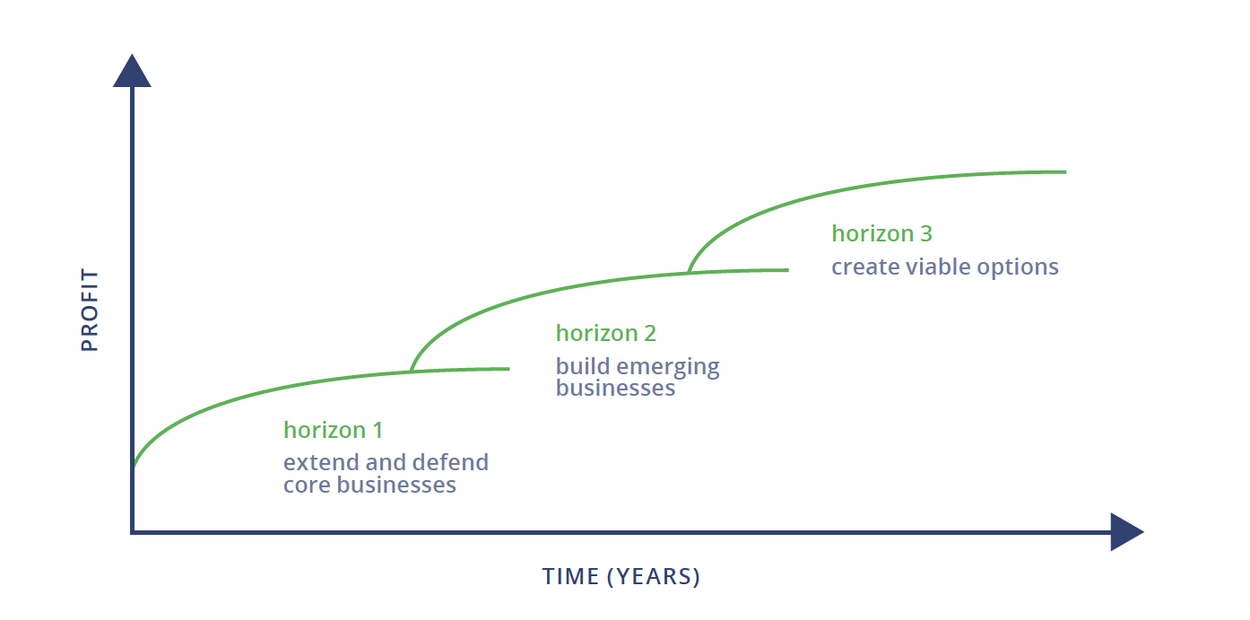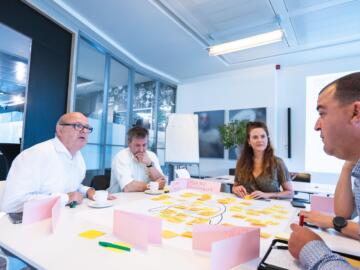Great things happen when people work together. This also applies to innovation. For greater innovation success, it pays to analyse what you’re good at and what not, and then look for partners with complementary capabilities. But how do you find those partners? And how can you develop an innovation ecosystem of partners that works for you?
Innovation is a continuous process of finding a creative match between an existing problem and a new solution. This process usually does not happen in a vacuum or in the secrecy of some corporate backroom. Successful innovators know perfectly well what they can do and where they need help.
The concept of innovation ecosystems is not new. Large companies have been working together with universities and startups with great success. Governments also support innovation, either by funding public research or by encouraging private investment in research and innovation. And, last but not least, more companies are discovering the value of an innovation lab, like TomorrowLab, to guide them along the innovation journey.
What can an innovation ecosystem do for you?
An ecosystem will offer more value in innovation projects that go beyond a company’s core business and are situated on a further horizon.
In its Three Horizon Model (see figure), management consultancy company McKinsey showed that innovation can be set out on different horizons in time. Horizon 1 refers to short-term projects that are close to a company’s core business. Horizon 2 refers to projects that include real business opportunities within three to five years, while Horizon 3 refers to more bold and disruptive projects that generally produce results in 5 to 12 years.
Most companies are well equipped and comfortable executing Horizon 1 innovation projects. Although these projects might be costly or technically challenging, in most cases they are straightforward to implement because they entail less market uncertainty. Examples of these could be new product features, process automation, optimisation projects, etc.
Companies that wish to avoid being disrupted and create future-proof business models are better off creating a balanced portfolio that includes Horizon 2 and 3 innovation projects. As these higher risk projects call for exploration outside the core business, they require new skills and capabilities which can be acquired through a carefully designed innovation ecosystem.
If you are looking for external help in these types of innovation projects, it might be a good idea to analyse your own portfolio of capabilities first. This way, you can decide where you need help and how you can add value to others. This mutual value transfer is crucial for any innovation ecosystem to succeed.

The need for speed
Successful innovators will start up Horizon 2 and 3 projects to make sure they grow in a sustainable way and are successful in the future. However, the pace of innovation today is faster than ever. To stay relevant, companies are looking for ways to get their innovations to the market in much shorter time frames.
Ecosystem stakeholders with complementary capabilities can help your business to speed up your innovation efforts and meet the needs of the ever more demanding customer. In innovation terms, speed here refers to how well and how fast you can learn as a company. The faster you can obtain insights on what innovation is feasible, desirable and viable, the more successful you will be as an innovator.
The faster you can obtain insights on what innovation is feasible, desirable and viable, the more successful you will be as an innovator.
How to choose your innovation ecosystem partners
It should be clear by now that an innovation ecosystem is not something you randomly end up in. On the contrary, your community of ecosystem partners should be the result of a careful selection process.
One important selection criterion is location. The reason why the world’s innovation hubs are where they are – think Silicon Valley, London or Shenzen – is not arbitrary. Usually, these locations offer an outstanding mix of success factors, as well as the presence of crucial innovation stakeholders, such as startups, universities, innovation labs, risk capital, and an innovation-friendly government.
In your search for ecosystem stakeholders, look specifically in those environments where innovation already thrives. To help you recognize these environments, we identified five critical parameters:
- Human capital: Innovation requires people with brains and courage. On the one hand, people with a STEM background (Science, Technology, Engineering and Mathematics) are needed to meet the challenges of the constant and rapid technological advancements. But that is not enough. Innovation also needs entrepreneurs, people who are not afraid to take risks.
- Risk capital: This is needed to make the necessary innovation investments possible. Risk capital can take many forms, ranging from angel investors over venture capitalists to government funding.
- Infrastructure: Innovation-friendly infrastructure can significantly improve a company’s innovation capabilities. Just think of the availability of 5G or the availability of specialized infrastructure for the industrial biotech community. Also, low-tech infrastructure such as corporate office space or resources (e.g. printers, screens, WIFI, etc.) can be offered to startups during their infancy.
- Market demand: An environment which already has a need for your product or service can help your business grow. For example, innovation around smart mobility solutions in densely populated areas such as Antwerp and Brussels, where traffic problems are rampant, are good environments that drive market demand. Also, governments and companies have an important role to play for creating demand. Through policies and regulations governments are able to create an environment where innovative solutions can be tested (e.g. autonomous vehicles, passenger drones, peer-to-peer energy sales, etc.). Companies can choose to give priority to startups when purchasing new products and services.
- Innovation culture: Successful innovation environments have a healthy attitude towards entrepreneurship and risk taking. Innovators should look for environments where companies are stimulated to embrace uncertainty, experiment, and risk the occasional failure.
Decide what you need from your innovation ecosystem
The better you can define what you need from your ecosystem, the greater your chance of success. Innovation is an intensive process that involves many stages between the first idea and the final implementation. An ecosystem partner can play various roles in that process. Before you decide where an ecosystem partner will fit in your innovation process, it is a good idea to map out how you currently do things.
Think about how you:
- Collect insights
- Detect customer needs
- Develop an innovation strategy
- Generate innovation ideas
- Implement your innovation projects
Not many businesses master the entire innovation process. Your ecosystem should help you in areas where you don’t excel. For example, a startup entrepreneur might be a good partner to generate ideas, while a large corporation might be able to give you access to a wider network.
Depending on the innovation horizon you are working on, you might need different skills as well. Startup companies might be a good partner for Horizon 2 projects, to help you explore adjacent markets or develop an emerging business. For early stage Horizon 3 projects, the research capabilities of a close university might be more suitable.
Of course, this works in both ways. Your ecosystem success also depends on how well you can provide for the innovation needs of your partners.
What can an innovation lab do for you?
External innovation labs and consultancy companies play an increasingly important role in today’s innovation ecosystems. The reason is obvious. We have arrived in an era where innovation happens so fast that many businesses are forced to step up their innovation efforts. An innovation partner like TomorrowLab, who has a proven track record in setting up innovation projects, can help companies to generate better ideas, understand market trends, and develop solutions for customers faster.
Again, the usefulness of an innovation lab’s capabilities will depend on how well you manage your innovation process and what skill gaps need to be filled. At TomorrowLab, we have supported companies with specific projects, such as organising hackathons, and by playing the role of an accelerator, helping companies to quickly test ideas in the market.
Other companies have relied on us for support during the entire innovation journey, which includes topics such as foresight, innovation strategy, innovation portfolio, innovation governance, idea generation, concept and business model development, implementation, ecosystem matchmaking and innovation culture.
What aspect of innovation is difficult for you? Do you have trouble getting your innovation projects off the ground? Have you started building your innovation ecosystem already? Let us know.

Innovation excellence program
Embed innovation in your company! Through a tailor-made program you will be able to anchor innovation in your strategy, way of working, organisational structure, culture and ecosystem.

The power of Transformational Leadership
The strength of the future lies in anticipation: if we all turn our heads in the same direction and try to understand what might happen, we will know what to do.
Living Tomorrow Academy
Klik hier voor de Nederlandstalige versie van deze pagina. Living Tomorrow Academy combines the best of not both, but all worlds: the international innovation platform of Living Tomorrow and our very own TomorrowLab coaches, complimented with top-notch experts and trainers from within our innovation ecosystem. And that is what makes Living Tomorrow Academy different: innovation training, taught by innovators.Together, we provide training programs on innovation, workshops and keynote speakers. We help you and your organisation to understand the future to make the right choices, to deliver new value by innovating, to build an innovative ecosystem, and to develop the skills and capabilities they need to innovate in the 21st century. We have different programs available, discover which program suits you and your organisation best: In-company trainingOpen trainingMoments of Inspiration

